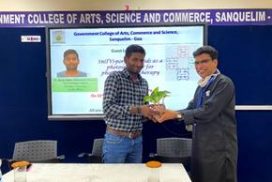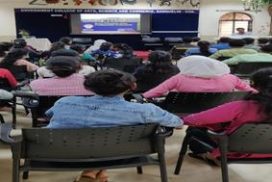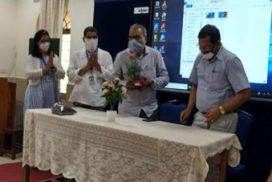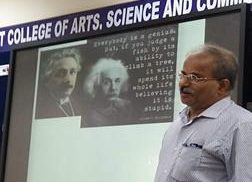
Teaching Learning
The department of Chemistry ensures an effective teaching-learning process, using ICT facilities and interactive sessions in the classroom between the students and teachers. The students are also subjected to an environment that corelates the theoretical and practical aspect of the syllabus. The students are allowed to keep their mind open and be innovative in their approach towards the subject. Remedial classes are engaged for students who need special attention to uplift them. Teachers also attend various seminars, symposiums and refresher courses to enable them to encourage students and inspire them for future studies and research.
Faculty Profile
 |
Mr. Ashok Chodankar
Associate Professor, Vice- Principal, Administration Joined GCASC- Sanquelim in 1989, specialised in Organic Chemistry Teaching Experience: 32 years |
 |
Ms. Rosalina Desilva
Associate Professor, Head of Department Joined GCASC- Sanquelim in 1990, specialised in Inorganic Chemistry Teaching Experience: 30 years Special Interest: Bio-inorganic Chemistry and Coordination Chemistry |
 |
Ms. Varsha Sail
Associate Professor, SET Joined GCASC- Sanquelim in 1996, specialised in Inorganic Chemistry Specialization Interest: Co-ordination Chemistry, Bio-inorganic Chemistry, Synthesis of Complex materials Teaching Experience: 25 years |
 |
Dr. Rajesh Parvatkar
Assistant Professor, Ph.D, NET Joined GCASC- Sanquelim in 2017, specialised in Organic Chemistry Specialization Interest: Organic Chemsitry, Natural Products Teaching Experience: 9 years Industrial Experience: 1.5 years |
 |
Dr. Dattaprasad Narulekar
Assistant Professor, Ph.D Joined GCASC- Sanquelim in 2021, specialised in Inorganic Chemistry Specialization Interest: Teaching Experience: 5 years |
 |
Dr. Sagar Patil
Assistant Professor, Ph.D, NET Joined GCASC- Sanquelim in 2021, specialised in Organic Chemistry Specialization Interest: Teaching Experience: 5.5 years Industrial Experience: 2 years (R&D) |
 |
Ms. Ankita Vernekar
Assistant Professor, B.Ed., SET Joined GCASC- Sanquelim in 2017 till date, specialised in Physical Chemistry Specialization Interest: Catalysis, Metal-oxide synthesis Teaching Experience: 4 years |
 |
Ms. Sujata Gaonkar
Assistant Professor, B.Ed., SET Joined GCASC- Sanquelim in 2018 till date, specialised in Physical Chemistry Specialization Interest: Metal-oxide synthesis, Catalysis Teaching Experience: 3 years |
 |
Dr. Rahul Kerkar
Assistant Professor, Ph.D, NET-JRF Joined GCASC- Sanquelim in 2020 till date, specialised in Inorganic Chemistry Specialization Interest: Metal-oxide synthesis, Heterogenous Catalysis, Materials Surface-Study, Gas-Phase reaction, Environmental Catalysis Teaching Experience: 1 year |
| Ms. Krutika Naik
Assistant Professor, SET Joined GCASC- Sanquelim in 2020 till date, specialised in Organic Chemistry Specialization Interest: Teaching Experience: 1 year |
|
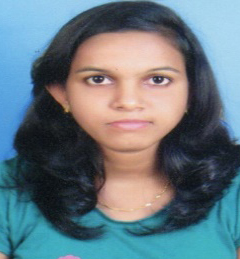 |
Dr. Madhavi Shete
Assistant Professor , Ph.D Joined GCASC- Sanquelim in 2021 till date, specialised in Physical Chemistry Specialization Interest: Catalysis, Electro-Catalysis Teaching Experience: 6 months |
 |
Mr. Sarvesh Harmalkar
Assistant Professor , SET, Ph.D thesis submitted Joined GCASC- Sanquelim in 2021 till date, specialised in Inorganic Chemistry Specialization Interest: Bio-Inorganic Teaching Experience: 6 months |
 |
Ms. Shraddha Pilgaonkar
Assistant Professor, SET Joined GCASC- Sanquelim in 2019 till date, specialised in Organic Chemistry Specialization Interest: Wittig reaction Teaching Experience: 5 years |
 |
Ms. Sneha Parab
Assistant Professor Joined GCASC- Sanquelim in 2019 till date, specialised in Physical Chemistry Specialization Interest: Teaching Experience: 4 years |
 |
Dr. Ram Uttam Gawas
Assistant Professor , Ph.D Joined GCASC- Sanquelim in 2021 till date, specialised in Pharmaceutical Chemistry Specialization Interest: Green Chemistry, Molecular Sensor, Mesoporous-based Sensor, Reaction in Mechanochemistry and Aqueous Water, AIE and ESIPT Sensor for biological and environmental analytes, Catalysis, Molecular Docking Teaching Experience: 5 years |
 |
Ms. Taniya Mapari
Assistant Professor Joined GCASC- Sanquelim in 2021 till date, specialised in Organic Chemistry Teaching Experience: 6 months |
 |
Ms. Shreya Mapari
Assistant Professor (Lecture Basis) Joined GCASC- Sanquelim in 2021 till date, specialised in Organic Chemistry Teaching Experience: 1.5 years |
Capacity Building:
Department of Chemistry provides the students with not only enrichment of the subject but encourages an all-round development. The students are encouraged to acquire other skills and improve on their inborne qualities. Various activities are held and programmes are organised to expose them on latest development. Lecture series aims at more informative and enterprising subjects. The students also get to attend talks on value education, career guidance, personality development and community service. The department also organises educational and industrial study trips to expose the students to new and modern instruments and educational and industrial processes. The students are also offered short term certificate courses to build their capacity and horne their skills.
Students Progression :
| Year | No. of Students appeared | No of Students passed |
| 2017-2018 | 37 | 34 |
| 2018-2019 | 67 | 40 |
| 2019-2020 | 66 | 66 |
| 2020-2021 | 80 | 80 |
Students pursuing higher studies:
| Name | Post graduation Education |
| Miss. Kanvi Mayanikar | MSc at Goa University |
| Miss. Kanti Mayanikar | MSc at Goa University |
| Mr. Hrithik Mandrekar | MSc at PES college |
| Mr. Mahadev Gaonkar | MSc at khandola college |
| Miss. Mridula jain | MSc at DM’s college |
| Miss. Pooja | MSc at St. Xaviers college |
| Mr. Rajat Gaonkar | MSc at khandola college |
| Miss. Rutuja | MSc at khandola college |
| Miss. Shalaka | MSc at khandola college |
| Miss. Siddhi dalvi | MSc at PES college |
| Miss. Chaitali parab | MSc at PES college |
| Mr. Sujay sawant | MSc at khandola college |
| Mr. Oumay sayyed | MSc at Goa University |
| Mr. Arun Joshi | MSc at khandola college |
| Miss. Samrudhi kelkar | MSc at Khandola college |
| Miss. Shraddha Thaneker | MSc at Goa University |
| Miss. Veda Pednekar | MSc at Goa University |
| Miss. Sneha Bhomkar | MSc at Dhempe college |
| Miss. Niyati Gawade | MSc at Chowgule college |
| Miss. Bhakti Karbotkar | MSc at St. Xaviers college |
| Miss. Saili satardekar | MSc at St. Xaviers college |
| Miss. Soudarya Naik | MSc at khandola college |
| Miss. Minika Kodalkar | MSc at khandola college |
| Miss. Trupti Gawas | MSc at khandola college |
| Miss. Prachita Gaonkar | MSc at Goa University |
| Miss. Vaishanavi Salakar | MSc at Goa University |
| Miss. Sarika Pednekar | MSc Bed |
| Miss. Shivani Shetye | MSc Bed |
| Miss. Shravani Amonkar | MSc at DM’s college |
| Miss. Sampada Bhide | MSc at Khandola college |
| Mr. Adesh Dalal | MSc at Chowgule college |
| Miss. Disha Malik | Pursuing PhD at Korea |
Distinguished Alumni
- Amit Verneker: Scientist, CSIR-CLRI, Chennai.
- Sarvesh Sawant: Associate Director R & D, Teva Pharmaceuticals, Verna Goa.
- Dnyaneshwar Gawas: Senior General Manager, API-R&D,Centre of Excellance, Unichem Laboratories Ltd. Pilerne, Goa.
- Girish Jalmi: Research Scientist (NMR Analyst), Alembic Pharmaceuticals, Vadodara Gujarat
- Aabaji Gawas : Quality Control Executive, Deccan Fine Chemical Limited, Corlim Goa.
- Sunder Dhuri : Professor at Goa University
- Rajesh Pednekar: Associate Professor at DM’s college, Assagao
- Mahesh Majik: Associate Professor at DHE
- Umesh Gawas: Associate Professor at DM’s college, Assagao
- Mahesh Nair: Assistant Professor, St. Xavier’s College, Mapusa, Goa.
- Vinod Mandrekar: Assistant Professor at Goa University
- Rohan Kunkalekar: Assistant Professor at Goa University
- Pranay Morajkar: Assistant Professor at Goa University
- Savita Kandolkar :Assistant Professor at Goa University
- Kedar Narvekar: Assistant Professor at Goa University
- Dattaprasad Narulkar: Assistant Professor at Govt.college Sanquelim.
- Madhavi Shete: Assistant Professor at Govt. College Sanquelim college
- Shraddha Piligaonkar Assistant Professor at Govt College Sanquelim college
- Prajakta Parab: Assistant Professor at Govt.college, Khandola
- Apurva Narvekar : Assistant Professor at Govt.college, Khandola
Courses
| Semester | Paper Course | Code | Name of the Paper | Credits |
| I | Core Course | CHC-101 | Inorganic Chemistry & Organic Chemistry | 6 = (4+2) |
| II | Core Course | CHC-102 | Physical Chemistry & Organic Chemistry | 6 = (4+2) |
| III | Core Course | CHC-103 | Physical Chemistry & Organic Chemistry | 6 = (4+2) |
| Skill Enhancement course | CHS-101 | Natural Resources & Analysis | 4 = (3+1) | |
| IV | Core Course | CHC-104 | Physical Chemistry & Inorganic Chemistry | 6 = (4+2) |
| Skill Enhancement course | CHS-106 | Advances in Energy Technology | 4 = (3+1) | |
| V | Core Course | CHC-105 | Physical Chemistry | 6 = (4+2) |
| CHC-106 | Inorganic Chemistry | 6 = (4+2) | ||
| CHC-107 | Organic Chemistry | 6 = (4+2) | ||
| Discipline Specific Elective | CHD-101 | Basic topics in Analytical Chemistry | 4 = (3+1) | |
| Discipline Specific Elective | CHD-105 | Properties and Processes of Molecular Chemistry | 4 = (4+0) | |
| VI | Core Course | CHC-108 | Physical Chemistry | 6 = (4+2) |
| CHC-109 | Inorganic Chemistry | 6 = (4+2) | ||
| CHC-110 | Organic Chemistry | 6 = (4+2) | ||
| Discipline Specific Elective | CHD-103 | Selected Instrumentation in Chemistry | 4 = (4+0) | |
| Project | CHP-101 | Project | 4 = (4+0) |
| Semester | Paper Course | Code | Name of the Paper | Credits |
| I | Core Course | CHC-101 | Inorganic Chemistry & Organic Chemistry | 6 = (4+2) |
| Section A
1. Atomic Structure (14 H) Review of Bohr’s theory and its limitations; dual behaviour of matter and radiation; de Broglie’s relation; Heisenberg Uncertainty principle; hydrogen atom spectra; need of a new approach to atomic structure; what is quantum mechanics? time independent Schrodinger equation and meaning of various terms in it; significance of ψ and ψ2; Schrödinger equation for hydrogen atom; radial and angular parts of the hydogenic wave functions (atomic orbitals) and their variations for 1s, 2s, 2p, 3s, 3p and 3d orbitals (only graphical representation); radial and angular nodes and their significance; radial distribution functions and the concept of the most probable distance with special reference to 1s and 2s atomic orbitals; quantum numbers and their significance; discovery of spin, spin quantum number(s) and magnetic spin quantum number (ms); shapes of s, p and d atomic orbitals: nodal planes; rules for filling electrons in various orbitals; electronic configurations of the atoms; stability of half-filled and filled-orbitals; concept of exchange energy; relative energies of atomic orbitals; anomalous electronic configurations. 2. Chemical Bonding and Molecular Structure (16 H) Ionic bonding: general characteristics of ionic bonding; energy considerations in ionic bonding; lattice energy and solvation energy and their importance in the context of stability and solubility of ionic compounds; statement of Born-Landé equation for calculation of lattice energy; Born-Haber cycle and its applications; polarizing power, and polarizability; Fajan’s rules; ionic character in covalent compounds; bond moment; dipole moment and percentage ionic character. Covalent bonding: VB approach; shapes of some inorganic molecules and ions on the basis of VSEPR and hybridization with suitable examples of linear, trigonal planar, square planar, tetrahedral, trigonal bipyramidal and octahedral arrangements; concept of resonance and resonating structures in various inorganic and organic compounds: MO approach; rules for the LCAO method, bonding and antibonding MOs and their characteristics for s-s, s-p and p-p combinations of atomic orbitals, nonbonding combination of orbitals, MO treatment of homonuclear diatomic molecules of 1st and 2nd periods (including idea of s-p mixing) and heteronuclear diatomic molecules such as CO, NO and NO+. Comparison of VB and MO approaches. Section B 3. Fundamentals of Organic Chemistry (8 H) Curved arrow notation, drawing electron movement with arrows, half and double headed arrows, in organic reaction mechanisms; physical effects, electronic displacements: inductive effect, electromeric effect, resonance and hyperconjugation. Cleavage of bonds: homolysis and heterolysis; structure, shape and reactivity of organic molecules: nucleophiles and electrophiles; reactive intermediates: carbocations, carbanions and free radicals; strength of organic acids and bases: comparative study with emphasis on factors affecting pk values; aromaticity: benzenoids and Hückel’s rule. 4. Stereochemistry (10 H) Concept of isomerism; types of isomerism; stereoisomerism, conformational isomerism; conformations with respect to ethane, butane and cyclohexane; interconversion of wedge formula, Newmann, Sawhorse and Fischer representations; concept of chirality (up to two carbon atoms); configuration: geometrical and optical isomerism; enantiomerism, diastereomerism and meso compounds); threo and erythro; D and L; cis – trans nomenclature; CIP Rules: R/ S (for up to 2 chiral carbon atoms) and E/Z Nomenclature (for up to two C=C systems). 5. Aliphatic Hydrocarbons (12 H) Functional group approach for the following reactions (preparations & reactions) to be studied in context to their structure; Alkanes (up to 5 carbons): preparation: catalytic hydrogenation, Wurtz reaction, Kolbe’s synthesis, from grignard reagent; reactions: free radical substitution: halogenation. Alkenes (up to 5 Carbons): preparation: elimination reactions: dehydration of alkenes and dehydrohalogenation of alkyl halides (Saytzeff’s rule); cis alkenes (partial catalytic hydrogenation) and trans alkenes (Birch reduction). Reactions: cis-addition (alk. KMnO4) and trans-addition (bromine), Addition of HX (Markownikoff’s and anti-Markownikoff’s addition), Hydration, Ozonolysis, oxymecuration - demercuration, Hydroboration-oxidation. Alkynes: (up to 5 Carbons) Preparation: Acetylene from CaC2 and conversion into higher alkynes; by dehalogenation of tetra halides and dehydrohalogenation of vicinal-dihalides. Reactions: formation of metal acetylides, addition of bromine and alkaline KMnO4, ozonolysis and oxidation with hot alkaline KMnO4. |
||||
| SECTION A
INORGANIC CHEMISTRY 15 Hours (0.5 Credit) Volumetric Analysis (3 x 5 = 15 Hours) 1. Estimation of sodium carbonate and sodium hydrogen carbonate present in a mixture. 2. Estimation of oxalic acid by titrating it with KMnO4. 3. Estimation of Fe (II) ions by titrating it with K2Cr2O7 using internal indicator. SECTION B ORGANIC CHEMISTRY 15 Hours (0.5 Credit) 1. Purification of organic compounds. (2 x 4 = 08 Hours) i) Solids by recrystallization process using water and ethanol as solvent. Determination of melting point. ii) Liquids by distillation process, a) acetone b) nitrobenzene. Determination of boiling point. 2. Determination of chemical type, detection of elements, group test for any five compounds. (07 Hours) |
||||
| Semester | Paper Course | Code | Name of the Paper | Credits |
| II | Core Course | CHC-102 | Physical Chemistry & Organic Chemistry | 6 = (4+2) |
| Section A (Physical Chemistry- I)
1. Chemical Energetics (10 H) Need of thermodynamics and the laws of thermodynamics. Important principles and definitions of thermochemistry. Concept of standard state and standard enthalpies of formations, integral and differential enthalpies of solution and dilution. Calculation of bond energy, bond dissociation energy and resonance energy from thermochemical data. Variation of enthalpy of a reaction with temperature – Kirchhoff’s equation. Statement of Third Law of thermodynamics and calculation of absolute entropies of substances. 2. Chemical Equilibrium (8 H) Free energy change in a chemical reaction. Thermodynamic derivation of the law of chemical equilibrium. Definition of ΔG and ΔGo, Le Chatelier’s principle. Relationships between Kp, Kc and Kx for reactions involving ideal gases. 3. Ionic Equilibria (12 H) Strong, moderate and weak electrolytes, degree of ionization, factors affecting degree of ionization, ionization constant and ionic product of water. Ionization of weak acids and bases, pH scale, common ion effect. Salt hydrolysis-calculation of hydrolysis constant, degree of hydrolysis and pH for different salts. Buffer solutions. Solubility and solubility product of sparingly soluble salts. Section B (Organic Chemistry – II) 4. Aromatic hydrocarbons (8 H) Preparation (case benzene): from phenol, by decarboxylation, from acetylene, from benzene sulphonic acid. Reactions: (case benzene): electrophilic substitution: nitration, halogenation and sulphonation. Friedel-Craft’s reaction (alkylation and acylation) (upto 4 carbons on benzene). Side chain oxidation of alkyl benzenes (up to 4 carbons on benzene). 5. Alkyl and Aryl Halides (8 H) Alkyl Halides (Upto 5 Carbons) Types of Nucleophilic Substitution (SN1, SN2 and SNi) reactions. Preparation: from alkenes and alcohols; reactions: hydrolysis, nitrite & nitro formation, nitrile & isonitrile formation; Elimination vs substitution. Aryl Halides Preparation: (chloro, bromo and iodo-benzene case): from phenol, Sandmeyer & Gattermann reactions; Reactions (Chlorobenzene): Aromatic nucleophilic substitution (replacement by –OH group) and effect of nitro substituent. Benzyne Mechanism: KNH2/NH3 (or NaNH2/NH3); Reactivity and Relative strength of C-halogen bond in alkyl, allyl, benzyl, vinyl and aryl halides. 6. Alcohols, Phenols, Ethers and Carbonyl Compounds (14 H) Alcohols: Preparation: Preparation of 1°, 2°and 3° alcohols: using Grignard reagent, Ester hydrolysis, Reduction of aldehydes, ketones, carboxylic acid and esters. Reactions: With sodium, HX (Lucas test), esterification, oxidation (with PCC, alk. KMnO4, acidic dichromate, conc. HNO3). Oppeneauer oxidation Diols: oxidation of diols using HIO4. Pinacol-Pinacolone rearrangement with mechanism. Phenols: (Phenol case) Preparation: Cumene hydroperoxide method, from diazonium salts. Reactions: Electrophilic substitution: Nitration, halogenation and sulphonation Reimer-Tiemann Reaction, Gattermann-Koch Reaction, Houben–Hoesch Condensation, Schotten –Baumann Reaction. Ethers (aliphatic and aromatic): Williamson’s synthesis of ethers. Cleavage of ethers with HI. Aldehydes and ketones (aliphatic and aromatic): (formaldehyde, acetaldehyde, acetone and benzaldehyde) Preparation: from acid chlorides and from nitriles. Reactions – Reaction with HCN, ROH, NaHSO3, NH2-G derivatives. Iodoform test. Aldol Condensation, Cannizzaro’s reaction, Wittig reaction, Benzoin condensation. Clemmensen reduction and Wolff Kishner reduction. Meerwein-Pondorff Verley reduction. |
||||
| PRACTICALS Number of hours: 60
Section A 1. Thermochemistry (Any three) (18 H) i. Determination of heat capacity of the calorimeter. ii. Determination of enthalpy of neutralization of hydrochloric acid with sodium hydroxide. iii. Determination of enthalpy of ionization of acetic acid. iv. Study of the solubility of benzoic acid in water and determination of ΔH. 2. Chemical Kinetics: (10 H) i. To study the effect of nature of reactants on the rate of reactions ii. Determination of relative strength between HCl and Urea hydrochloride for hydrolysis of methyl acetate Ionic equilibria. 3. pH measurements (2 H) Measurement of pH of different solutions like aerated drinks, fruit juices, shampoos and soaps (use dilute solutions of soaps and shampoos to prevent damage to the glass electrode) using ph meter. Section B 4. Preparations (30 H) Mechanisms involved in the following reactions to be discussed. Recrystallisation, determination of melting point and calculation of quantitative yields to be done. Each preparation for a. Bromination of Phenol/Aniline b. (b) Benzoylation of amines/phenols c. 2,4-dinitrophenylhydrazone of benzaldehyde/acetophenone d. Nitration of acetanilide to p-nitroacetanilide. e. (e) Oxime of Cyclohexanone f. Chalcone from benzaldehyde and acetophenone g. Iodoform from acetone |
||||
| Semester | Paper Course | Code | Name of the Paper | Credits |
| III | Core Course | CHC-103 | Physical Chemistry & Organic Chemistry | 6 = (4+2) |
| Section A
1. Solutions (7 H) Thermodynamics of ideal solutions: Ideal solutions and Raoult’s law, deviations from Raoult’s law – non-ideal solutions. Vapour pressure-composition and temperature composition curves of ideal and non-ideal solutions. Azeotropes. Partial miscibility of liquids: Critical solution temperature, distillation and fractional distillation. 2. Phase Equilibrium (8 H) Phases, components and degrees of freedom of a system, criteria of phase Equilibrium. Phase diagrams of one-component systems (water, sulphur and CO2) Component and two systems involving eutectics, congruent and incongruent melting points (Zn-Mg, NaCl-H2O). 3. Conductance (5 H) Conductivity, equivalent and molar conductivity and their variation with dilution for weak and strong electrolytes. Kohlrausch’s law of independent migration of ions. Ionic mobility and factors affecting ionic mobility. Transference number and its experimental determination using moving boundary methods. Applications of conductance water, measurements: solubility and solubility products of sparingly soluble salts, ionic product of conductometric titrations (only acid-base). 4. Electrochemistry (7 H) Reversible and irreversible cells. Concept of EMF of a cell. Measurement of EMF of a cell. Nernst equation and its importance. Types of electrodes. Standard electrode potential. Electrochemical series. Thermodynamics of a reversible cell, Concentration cells with transference and without transference. Liquid junction potential and salt bridge. pH determination using a hydrogen electrode and quinhydrone electrode. Section B 5. Carboxylic acids and their derivatives (10 H) Carboxylic acids (aliphatic and aromatic); Preparation: Acidic and Alkaline hydrolysis of esters. Reactions: Hell - Volhard - Zelinsky Reaction. Carboxylic acid derivatives (aliphatic): (up to 5 carbons) Preparation: Acid chlorides, Anhydrides, Esters and Amides from acids and their interconversions, Reactions: Comparative study of thenucleophilicity of acyl derivatives. Reformatsky reaction, Perkin condensation (mechanism). 6. Amines and Diazonium Salts (6 H) Amines (aliphatic and aromatic): (upto 5 carbons) Preparation: from alkyl halides, Gabriel’s phthalimide synthesis, Hofmann bromamide reaction (Hofmann rearrangement). Reactions: Hofmann vs. Saytzeff elimination, Carbylamine test, Hinsberg test, with HNO2, Schotten – Baumann reaction. Electrophilic substitution (case aniline): nitration,bromination, sulphonation. Diazonium salts: Preparation from aromatic amines, conversion to benzene, phenol, dyes. 7. Amino Acids and Peptides (6 H) Preparation of Amino Acids: Strecker synthesis, Gabriel’s phthalimide synthesis. Terms: Zwitterion, Isoelectric point and Electrophoresis. Reactions of Amino acids: Ester of – COOH group, acetylation of –NH2 group, complexation with Cu2+ ions, ninhydrin test. Synthesis of simple peptides (upto dipeptides) by N-protection (t-butyloxycarbonyl and phthaloyl) & C-activating groups and Merrifield solid-phase synthesis. 8. UV –Visible Spectroscopy in Organic Chemistry (6 H) Introduction to spectroscopy: UV Spectroscopy: Beer-Lambert’s law, Types of electronic transitions, λmax, Chromophores and Auxochromes, Bathochromic and Hypsochromic shifts, Intensity of absorption. Visible Spectroscopy: Effect of conjugation on colour. Application of Woodward - Fieser rules for calculation of λmax for the following systems: α, β unsaturated aldehydes, ketones. Conjugated dienes: alicyclic, homoannular and heteroannular, extended conjugated systems (aldehydes, ketones and dienes). Distinction between cis and trans isomers. 9. Carbohydrates (8 H) Classification and General Properties, Glucose and Fructose (open chain and cyclic structure), Determination of configuration of monosaccharides, absolute configuration of Glucose and Fructose, Mutarotation, Osazone formation, Killiani Fischer synthesis. |
||||
| `Section A (PHYSICAL CHEMISTRY)
Phase Equilibria (10 H) 1. To draw the phase diagram of the binary system - diphenyl amine and α – Naphthol and find the eutectic temperature. 2. Study the mutual solubility of phenol and water at various temperatures and hence determine the critical solution temperature. 3. Study the effect of addition of NaCl on critical solution temperature of phenol water system and study of the effect of impurities on it. Conductance (8 H) 1. Determination of cell constant. 2. Determination of equivalent conductance, degree of dissociation and dissociation constant of a weak acid. 3. Conductometric titrations: i. Strong acid vs. strong base ii. Weak acid vs. strong base Potentiometry (12 H) Potentiometric titrations 1. Strong acid vs. strong base (Quinhydrone method) 2. Potassium dichromate vs. Ferrous Ammonium sulphate Section B (ORGANIC CHEMISTRY) 1. Systematic Qualitative Organic Analysis (12 H) Analysis of Organic Compounds possessing monofunctional groups (carboxylic, aldehyde, ketone, amide, nitro, amines) and preparation of one derivative of each group. (Analysis of single compound and its derivative preparation) ethylacetoacetate. 2. Organic Preparations: (14 H) Synthesis, yield, recrystallisation and Melting Point. A. Hippuric acid from glycine (Benzoylation-Schotten Baumann reaction) (4 Hours) B. Osazone from Glucose (Nucleophilic addition) (2 Hours) C. Phthalic acid to Phthalic Anhydride to Phthalimide (4 Hours) D. Preparation of Azo dye (4 Hours) 3. Organic Estimations: (Any 2) (4 H) A. Estimation of glycine by formylation method (2 Hours) B. Estimation of Glucose by oxidation (2 Hours) C. Estimation of Acetamide by hydrolysis |
||||
| Skill Enhancement course | CHS-101 | Natural Resources & Analysis | 4 = (3+1) | |
| 1. Review of energy sources (renewable and non-renewable) (2 H)
Classification of fuels and their calorific value. 2. Coal (10 H) Uses of coal (fuel and nonfuel) in various industries, its composition, carbonization of coal. Coal gas, Producer gas and Water gas—composition and uses. Fractionation of coal tar, uses of coal tar, requisites of a good metallurgical coke, coal gasification (Hydrogasification and Catalytic gasification), coal liquefaction and solvent refining. 3. Petroleum and Petrochemical Industry (10 H) Composition of crude petroleum, Refining and different types of petroleum products and their applications. Fractional Distillation (Principle and process), Cracking (Thermal and catalytic cracking), Reforming petroleum and non-petroleum fuels (LPG, CNG, LNG, bio-gas, fuels derived from biomass), fuel from waste, synthetic fuels (gaseous and liquids), clean fuels. Petrochemicals: Vinyl acetate, Propylene oxide, Isoprene, Butadiene, Toluene and its Derivatives. 4. Analysis of food products (10 H) Nutritional value of foods, idea about food processing and food preservation and adulteration. a) Identification of adulterants in some common food items like coffee powder, asafoetida, chilli powder, turmeric powder, coriander powder, pulses etc. b) Analysis of preservatives and colouring matter. 5. Analysis of soil (7 H) Composition of soil, Concept of pH and pH measurement, complexometric titrations, chelation, chelating agents, use of indicators. 6. Analysis of water (8 H) Definition of pure water, sources responsible for contaminating water, water sampling methods, water purification methods. |
||||
| PRACTICALS Number of hours: 30
1. Determination of pH of soil samples. 2. Determination of pH of water samples. 3. Estimation of Calcium and Magnesium ions as calcium carbonate by complexometric titration. 4. Determination of dissolved oxygen (DO) in a given water sample. 5. Determination of acidity of a water sample. 6. Determination of alkalinity in a given water sample 7. Measurement of dissolved CO2. 8. Percentage of available chlorine in bleaching powder. |
||||
| Semester | Paper Course | Code | Name of the Paper | Credits |
| IV | Core Course | CHC-104 | Physical Chemistry & Inorganic Chemistry | 6 = (4+2) |
| Section A
1. Kinetic Theory of Gases (8H) Postulates of Kinetic Theory of Gases, deviation of real gases from ideal behaviour, compressibility factor, causes of deviation. van der Waals equation of state for real gases. Boyle temperature (derivation not required). Critical phenomena, critical constants and their calculation from van der Waals equation. Andrew’s isotherms for CO2. Maxwell Boltzmann distribution laws of molecular velocities and molecular energies (graphic representation – derivation not required) and their importance. Temperature dependence of these distributions. Most probable, average and root mean square velocities (no derivation), collision number, collision frequency, collision diameter and mean free path of molecules. 2. Liquids (6 H) Surface tension and its determination using stalagmometer. Effect of temperature on surface tension. Viscosity of a liquid and determination of coefficient of viscosity using Ostwald viscometer and factors affecting viscosity. 3. Solids (8 H) Forms of solids, symmetry elements, unit cells, crystal systems, Bravais lattice. Laws of crystallography - Law of constancy of interfacial angles, Law of rational indices. Miller indices, X–Ray diffraction by crystals, Bragg’s law. Particle size determination using powder method. Structures of NaCl, KCl and CsCl (qualitative treatment only) 4. Chemical Kinetics (8 H) The concept of reaction rates. Effect of temperature, pressure and catalyst on reaction rates. Order and molecularity of a reaction. Derivation of integrated rate equations for zero, first and second order reactions (both for equal and unequal concentrations of reactants). Half–life of a reaction. General methods for determination of order of a reaction. Concept of activation energy and its calculation from Arrhenius equation. Theories of Reaction Rates: Collision theory and Activated Complex theory of bimolecular reactions. Section B 5. Transition Elements (10 H) General characteristic properties of 3d series with special reference to electronic configuration, variable valency, color, magnetic and catalytic properties. Ability to form complexes and stability of various oxidation states (Latimer diagrams) for Mn, Fe, and Cu. Lanthanides: Electronic configurations, oxidation states, color, magnetic properties, lanthanide contraction, separation of lanthanides (ion exchange method only). Actinides: Electronic configuration and general characteristics. 6. Coordination Chemistry (10 H) IUPAC system of nomenclature. Bonding in complexes based on Valence Bond Theory (VBT), Inner and outer orbital complexes of Cr, Fe, Co, Ni, and Cu (coordination numbers 4 and 6). Different types of structural and stereo-isomerism including optical isomerism in complexes with coordination numbers 4 and 6. Drawbacks of VBT. 7. Crystal Field Theory (10 H) Crystal field splitting in octahedral complexes. Crystal field stabilization energy (CFSE), Crystal field effects for weak and strong fields. Spectrochemical series. Crystal Field Splitting in Tetrahedral complexes. Calculation of CFSE. Comparison of CFSE for Oh and Td complexes. Factors affecting the magnitude of 10Dq. Merits and Demerits of Crystal Field Theory. |
||||
| Section A (Physical Chemistry)
1. Surface Tension measurement (4 H) Determination of the surface tension of a liquid or a dilute solution using a stalagmometer. II. Solutions of Solids in Liquids (4 H) Determine solubility curve for KCl from 250C to 500C. III. Viscosity measurement (10 H) a. Determination of the viscosity of a liquid or dilute solution using an Ostwald’s viscometer. b. Study of the variation of viscosity of an aqueous solution with concentration of solute. IV. Chemical Kinetics (12 H) a. To determine the rate constant and order of reaction between KI and K2S2O8. b. Study of saponification of ethyl acetate with sodium hydroxide at equal concentration of ester and alkali. c. Compare the strengths of HCl and H2SO4 by studying kinetics of hydrolysis of methyl acetate. Section B (Inorganic Chemistry) I. Semi-micro qualitative analysis: not more than four ionic species (two anions and two cations): (4 Mixtures) (12 H) Cations: NH4+, Pb2+, Ag+, Bi3+, Cu2+, Cd2+, Sn2+, Fe3+, Al3+, Co2+, Cr3+, Ni2+, Mn2+, Zn2+, Ba2+, Sr2+, Ca2+, K+. Anions: CO32-, S2–, SO2–, SO42-, NO3–, Cl–, Br–, I–, NO2–, PO43-, F- II. Gravimetric/Volumetric (12 H) 1. Estimate the amount of Nickel present in a given solution as bis (dimethylglyoximato) Nickel(II) gravimetrically by counterpoise filter paper. 2. Estimation of (i) Mg2+ or (ii) Zn2+ by complexometric titrations using EDTA. 3. To estimate the amount of Bismuth present in the given solution of Bi(NO3)2.3H2O by complexometric titration. 4. To estimate the amount of Nitrite present in the given NaNO2 solution by titrating v/s Ceric ammonium sulphate /Ceric sulphate. III. Colorimetric Experiments (6 H) 1. Draw calibration curve (absorbance at λmax v/s concentration) for various concentrations of a given coloured compound (KMnO4/ CuSO4) and estimate the concentration of the same in a given solution. 2. Determine the composition of the Fe3+-salicylic acid complex solution by Job’s method. |
||||
| Skill Enhancement course
CHS-106 |
Advances in Energy Technology | 4 = (3+1) | ||
| 1. INTRODUCTION (10 H) 1.1 Man, and Energy.
1.2 Chemical Energy System, Electrochemical energy system. 1.3 Resources and energy: natural resources- energy environment triangle, energy problem, World energy resources, Energy conversion, Energy conversion processes. 1.4 Future Energy Resources. 2. CHEMICAL ENERGY SOURCES (15 H) 2.1 Petroleum: Origin, nature of sources of material for crude oil, composition of petroleum, refining of petroleum, products derived from petroleum. 2.2 Natural gas: Occurrence, natural gas liquid. 2.3 Coal: Origin, constitution of coal, coal gasification, and indirect liquification, purification of synthesis gas. Water gas shift process, indirect liquification, direct liquification, coal combustion, chemical obtained from coal. 2.4 Nuclear Fission: Power from nuclear fission, light water reactors (LWR), heavy water reactor (HWRs), Gas cooled reactors (GCRs), fast breeder reactors (FBRs) 2.5 Nuclear Fusion: Cold fusion 3. ELECTROCHEMICAL ENERGY SYSTEM (15 H) 3.1 Introduction, fundamentals of batteries, choice of materials, classification of batteries, sizes of batteries. 3.2 Some common batteries: Button cells, Portable equipment batteries, SLI batteries, Vehicle traction batteries, Stationary batteries, Battery characteristic power density. 3.3 Primary batteries: Combination of materials for a primary battery, alkaline MnO2 batteries performance and advantages, secondary batteries. 3.4 Types and classification, sealed storage batteries, metal hydride electrode. 3.5 Reserve Batteries: Introduction, classification, liquid activated, water activated Batteries, gas activated batteries, heat activated batteries, and Lithium based conducting polymer batteries, Lithium batteries and heart pacers. 4. FUEL CELLS (10 H) 4.1 Introduction, Classification, Choice of electrolyte. Electrodes and requirement of Electrocatalysis. 4.2 Biochemical Fuel cells. Characteristic, Classification, Mechanisms and Application. 4.3 Use of carbon in fuel cells, Fuel cells using Carbon nano materials. 5. SOLAR ENERGY (10 H) 5.1 Photochemical and photogalvanic conversion. 5.2 Hydrogen energy: Merits of hydrogen fuel cell, Hydrogen economy concept, Photo assisted electrolysis of water. 5.3 Biomass: Resources, Wood- a measure renewable resource and Biochemical routes. 5.4 Gasohol, Hydrogen storage by Metal alloys. 5.5 Miscellaneous Sources: Tidal Energy, Geothermal Energy. |
||||
| Practicals: 30 HOURS ( 01 Credit)
A. Electrochemical Energy 1. Construct a Daniel cell and determine the voltage of the cell at varying concentration. (4 Hours) 2. Determination of electrochemical equivalent of copper (4 Hours) B. Supports for Electro-catalyst 1. Preparation of Carbon ( from Coconut shell) and determination of surface area using volumetric method. (4 Hours) 2. Verification of Fruendlich adsorption isotherm of Coconut shell Carbon. (4 Hours) C. Photochemical Energy 1. Extraction of photosynthetic pigments from different parts of the plants and its identification from absorption wavelength (2 samples to be studied) (4 Hours) 2. Kinetics of photochemical reactions between iodine and oxalate using visible light (Colorimetrically) (4 Hours) D. Sources of Chemical Energy 1. Determination of moisture content in the sample of coal/ charcoal. (2 Hours) 2. Determination of sulphur and ash content in the sample of Coal/Charcoal. (4 Hours) |
||||
| Semester | Paper Course | Code | Name of the Paper | Credits | ||
| V | Core Course | CHC-105 | Physical Chemistry | 6 = (4+2) | ||
| SECTION A
1. Nuclear Chemistry I (10 H) Composition of the nucleus, nuclear binding forces and energy, nuclear stability, nucleon –nucleon forces and their equality, characteristics and theory of nuclear forces, nuclear models, radioactive disintegration, decay constant, half- life and average life, units of radioactivity, artificial radioactivity, detection and measurement of radioactivity, GM counter, semiconductor and proportional counter, Scintillation counter, characteristics of suitable scintillator. (numericals to be solved) 2. Electrochemistry I (20 H) Ion-selective electrodes: Fixed-site membrane, mobile-site membrane, site-free membrane, construction of ion selective electrodes, applications of ion selective electrodes. Decomposition potential, experimental determination of decomposition potential, application of decomposition potential, overvoltage and overpotential, theory of overvoltage, experimental determination of overvoltage, factors affecting overvoltage, hydrogen overvoltage, oxygen overvoltage, metal overvoltage. Fuel cells; H2-O2, Molten Carbonate Fuel cell, Proton exchange membrane fuel cell, Solid Oxide Fuel cell, Electrochemical Sensors; sensors, Principle, advantages and applications. SECTION B 3. Quantum Chemistry I (16 H) Mathematical Concepts: Derivatives and integrations, trigonometric functions, exponential functions, second derivatives of the functions. De-Broglie hypothesis, Heisenberg Uncertainty principle, sinusoidal wave function, terms involved in Quantum mechanics: Normalisation, orthogonality, observables, operators, stationary states, and variables. Schrodinger equation and its application to free particle and “particle in a box” (rigorous treatment) quantisation of energy levels, zero – point energy, Schrodinger equation in Cartesian and spherical polar (derivation not required), Extension to two- and three-dimensional boxes, separation of variables, degeneracy. Operators (Hermitian, non-Hermitian), eigen value and eigen functions, physical significance of wave function, examples of operators, Hamiltonian operators, Quantum mechanical operators and commutation rules Postulates of quantum mechanics, wave functions, probability distribution functions, nodal properties. 4. Molecular Spectroscopy I (14 H) Interaction of electromagnetic radiation with molecules and various types of spectra, Born Oppenheimer approximation. Rotational Spectroscopy: selection rules, intensities of spectral lines, determination of bond lengths of diatomic and linear triatomic molecules, isotopic substitution. Vibrational spectroscopy: Classical equation of vibration, computation of force constant, amplitude of diatomic molecular vibrations, anharmonicity, Morse potential, dissociation energies, fundamental frequencies, overtones, hot bands, degree of freedom for polyatomic molecules, modes of vibration, concept of group frequencies. Vibration –rotation spectroscopy: Diatomic vibrating rotator, P, Q, R branches Raman spectroscopy: Qualitative treatment of Rotational Raman effect, Vibrational Raman spectra, Raman effect, Stokes and Anti-stokes lines, their intensity difference, Quantum and Classical theories of Raman effect rule of mutual exclusion principle. |
||||||
| PRACTICALS Number of hours: 60
1. To study the kinetics of iodine clock reactions. 2. To determine the strength of mixture containing weak acid and salt of weak base by titrating against standard 0.1N NaOH solution conductometrically. 3. To determine the dissociation constant of a weak monobasic acid using pH metry. 4. To determine the percentage composition and amount of halides from a mixture (any two halide) using standard 0.1N AgNO3 solution. 5. To study the adsorption of Acetic acid by charcoal and to verify Freundlich adsorption isotherm. 6. To determine the energy of activation of hydrolysis of ethyl acetate (unequal concentration) 7. To determine degree of hydrolysis and hydrolysis constant of CH3COONa/ NH4Cl. Minor Experiments 1) Using vibrational-rotational spectra of HCl molecule; (A) Assign the rotational lines to various transitions. (B) Calculate (I) The value of B0 and B1, for R and P branches of spectra. (II) Vibrational frequency and (III) Inter nuclear distance 2) Using vibrational-rotational spectra of HBr molecule: (A) Assign the rotational lines to various transitions. (B) Calculate (I) The value of B0 and B1, for R and P branches of spectra. (II) Vibrational frequency and (III) Inter nuclear distance 3) To determine Standard Reduction Potential of Zn++/Zn. 4) To determine Standard Reduction Potential of Cu++/Cu. 5) To determine the solubility product of AgCl of 0.1 M AgNO3. 6) To determine the solubility product of AgCl of 0.05 M AgNO3. 7) To determine the solubility product of AgCl of 0.01 M AgNO3 |
||||||
| CHC-106 | Inorganic Chemistry | 6 = (4+2) | ||||
| SECTION A
1. Periodicity of Elements (10 H) Detailed discussion of the following: Properties of the elements with their trends in the periodic table. a. Atomic radii (van der Waals) b. Ionic radii and Covalent radii. c. Effective nuclear charge, shielding or screening effect, Slater rules. d. Ionization Energy, Successive ionization energies and factors affecting ionization energy. e. Electron Affinity. f. Electronegativity, Pauling’s/ Mulliken’s/Alfred and Rochow’s. Calculation of Electronegativity (Pauling’s Method), Factors affecting Electronegativity. 2. Chemistry of halogens (8 H) General methods of preparation, structure, bonding and chemical properties of: i) Interhalogens ii) Polyhalides ions iii) Oxoacids of halogens in different oxidation states iv) Pseudo halogens. 3. Noble Gases (4 H) Occurrence and uses, inertness of noble gases, Clathrates; preparation properties and structure (VSEPR) of XeF2, XeF4 and XeF6. 4. Inorganic Solid-State Chemistry (8 H) Defects in solids, Point defects; Schottky and Frenkel defects, Colour Centre, Extended defects and Non-stoichiometry. Band Theory of solids: Band gaps, Metals, Insulators and Semi-conductors. SECTION B 5. Bonding in Co-ordination Compounds (12 H) Werner’s theory and its experimental verification Evidences for Covalent bonding in complexes; Stereochemistry of Co-ordination Compounds with different co-ordination Numbers A. Ligand Field Theory (Adjusted Crystal Field Theory) –Brief Introduction; Comparison of the CFT and MOT. B. Molecular Orbital Theory as applied to Octahedral Complexes. Stability of complexes and factors affecting stability. C. Molecular orbitals diagrams of [Ti (H2O)6]+3, [Fe (CN)6]-3 , [FeF6]-3 and [Co (NH3)6]+3 Complexes. Effect of π - bonding on splitting parameter. 6. Oxidation and Reduction (8 H) Oxidation number, single electrode potential, Standard electrode potential and Electrochemical series. Energy cycle for electrode potential. Application of Electrochemical series to check feasibility of reaction. Hydrogen overvoltage and Oxygen overvoltage. The use of reduction potentials, redox cycle, redox stability in water. The diagrammatic presentation of potential data - Frost, Latimer and Pourbaix diagrams. Principles involved in the extraction of the elements. 7. Selected Topics A) Nano chemistry (5 H) Introduction to Nano particles, their properties, carbon nanotubes, SWCNT, MWCNT, different types of nanomaterials and their applications. B) Bio-inorganic Chemistry (5 H) Overview, essential and trace elements in biological processes, Metalloporphyrins with special reference to haemoglobin and myoglobin. The role of Model systems, The alkali and alkaline earth metals, Metalloenzymes, Nitrogen fixation: Bacterial nitrogenase system (The biological nitrogen cycle). |
||||||
| PRACTICALS Number of hours: 60
Gravimetric Estimations 1. To estimate the amount of Al as Al2O3 in the given solution of aluminum sulphate. 2. To estimate the amount of Fe as Fe2O3 in the given solution of ferric chloride containing barium chloride and free HCl. 3. To estimate the amount of nickel as Ni-DMG in the solution of nickel chloride containing copper chloride and free HCl. 4. To estimate the amount of barium as BaCrO4 in the solution of barium chloride containing ferric chloride and free HCl. 5. To estimate the amount of Zinc as Zn2P2O7 in the given solution of zinc sulphate containing copper sulphate and free H2SO4. Inorganic Preparations 1. Preparation Potassium trioxalatoferrate (III). 2. Preparation of potassium trioxalatoaluminate (III). 3. Preparation of Tristhioureacopper (I) sulphate. 4. Guignet’s green (hydrated chromium oxide). 5. Cobalt blue (azure). |
||||||
| CHC-107 | Organic Chemistry | 6 = (4+2) | ||||
| Section A
1. Aromaticity, Aromatic hydrocarbons and Reactivity (6 H) Huckel’s rule of Aromaticity (4n+2) Rule, 4n Rule for antiaromaticity, Electrophilic Aromatic substitution (w.r.t Benzene): Mechanism of Nitration, Sulphonation, Halogenation, Friedel – Crafts alkylation and acylation. Reactivity and orientation of activating, deactivating groups (ortho, para and meta effects). Nucleophilic aromatic substitution of Aryl halides (SNAr mechanism) 2. Alkaloids (6 H) Ziesel’s Method, Herzig-Meyer’s method, Hoffman’s exhaustive methylation method. Structure elucidation of Nicotine, Papaverine and Hygrine. Synthesis of Nicotine from Succinimide. Synthesis of Papaverine using Bischler-Napieralski reaction. Synthesis of Hygrine from Pyrrole. 3. Spectroscopic methods in Organic Chemistry (18 H) Infra-Red Spectroscopy: Principle of I.R Spectroscopy (Hooke’s law), types of molecular vibrations (Stretching and bending). Source, instrumentation and working of I.R spectrophotometer. Functional group region and Fingerprint region. Applications of I. R. Spectroscopy: Functional group analysis, detection of purity of sample, establishing the identity of an unknown molecule, Effect of H-bonding, conjugation, resonance and ring size on IR absorptions. To study the progress of a reaction. Problems based on I.R. spectroscopy (ketone, aldehyde, ester, acid & alcohol). Nuclear Magnetic Resonance Spectroscopy: Basic Principles of 1H NMR spectroscopy, Number of signals (Homotopic, Enantiotopic, diastereotopic protons). Position of signals, Chemical shift: Reference standard, Solvent effect, Shielding and de-shielding effect, anisotropic effects in alkenes, alkynes, aldehydes, aromatic compounds, factors affecting chemical shift. Intensity of signals: Peak area and proton counting. Spin-Spin coupling: Coupling constant (J). Interpretation of NMR spectra of simple compounds. (acetone, acetaldehyde, toluene, ethyl bromide, anisole, acetic acid, t-butylbenzene, 2-butanone, propene). Simple problems based on NMR spectral data for identification of molecule. Carbon-13 Nuclear Magnetic Resonance Spectroscopy and Mass Spectrometry: Principle of 13C spectroscopy. Number of signals: Proton coupled and decoupled spectra (off-resonance). Position of signals. Factors affecting position of signals (hybridisation). Problems based on 13C spectroscopy. Principle, theory, instrumentation of Mass spectrometry. Base Peak, Molecular ion, Metastable ion. Fragmentation pattern for alkanes. Fragmentation pattern of ketones: αcleavage and McLafferty rearrangement. Isotopic effect of alkyl halides. Section B 4. Chemistry of Heterocyclic Compounds (18 H) Definition of heterocyclic compounds: Organic compounds containing oxygen, sulphur, nitrogen. Classification with examples for three, four, five and six membered heterocycles. Structure, resonance, stability and industrial source of furan, pyrrole, thiophene and pyridine. Preparation of furan, pyrrole and thiophene using Paal Knorr Synthesis. Reactivity of furan, pyrrole and thiophene: Electrophilic substitution at 2/5 position. Preparation of pyridine using Hantzsch synthesis. Reactivity of pyridine: Electrophilic substitution at 3 position, Nucleophilic substitution at 2 and 4 position. Definition of bicyclic heterocycles with examples. Structure, resonance, stability and industrial source of indole, quinoline, isoquinoline. Preparation of indole using Fischer indole synthesis. Reactivity of Indole: Electrophilic substitution at 3 position. Skraup synthesis of quinoline and Bischler Napieralski synthesis of isoquinoline. Reactivity of quinoline and isoquinoline: Electrophilic substitution at 5/8 position, Nucleophilic substitution at 2 and 4 position. Oxidation and Reduction of quinoline and Isoquinoline. 5. Vitamins and Hormones (6 H) Structure elucidation of Vitamin A, Vitamin C, Thyroxine and Adrenaline. Synthesis :Vitamin A from β-ionone ,Vitamin C from xylose , Adrenaline from Catechol and thyroxine from tyrosine. 6. Dyes (6 H) Classification of dyes: Acidic, basic, azo, reactive, Vat, mordant, direct, disperse with one example and structure of each class. Reasons for colour of some molecules: Resonance effect in p-nitroaniline and nitrobenzene, conjugation effect in β-carotene and graphite. Synthesis and chemistry of phenolphthalein, congo-red, crystal violet, methyl orange. |
||||||
| PRACTICALS Number of hours: 60
1. Organic Preparations (Two steps): (Any 5) Synthesis, yield, recrystallisation and Melting Point. i) Nitrobenzene to m-nitroaniline ii) Phthalimide to 2-iodobenzoic acid iii) Acetanilide to p-nitroaniline iv) Benzamide to m-nitrobenzoic acid v) Benzoin to benzilic acid vi) Acetophenone to acetanilide vii)Benzophenone to benzanilide 2. Organic Estimations (Any 3) a) Acid+ Amide b) Acid + Ester c) Estimation of the number of acetyl groups in an acetyl ester. (Triacetyl glycerol, Hexaacetyl mannitol or Pentaacetyl glucose) (Any one) . d) Estimation of nitro group by reduction using stannous chloride 3. Synthesis of dyes a) Diazoaminobenzene b) Picric acid 4. Interpretation of Infra-Red, and proton NMR spectra a) IR spectra of the following: aldehyde, alcohol, ketone, carboxylic acid, amine, nitrile. b) Proton NMR of simple organic compounds (6 compounds) 5. Identification and Separation of following Organic binary mixtures Water insoluble –water insoluble (Acid-Base, Acid-Phenol, Base-Neutral, Acid-Neutral, Phenol-Base, Phenol-Neutral), Water soluble- water insoluble (Acid-Acid, Acid-Neutral, Neutral-Neutral), Liquid-Liquid (2 mixtures), Solid-liquid (2 mixtures). |
||||||
| Discipline Specific Elective | CHD-101
|
Basic topics in Analytical Chemistry | 4 = (3+1) | |||
| 1. Introduction (3 H)
Scope and importance of analytical chemistry, chemical analysis and analytical chemistry. Classification of instrumental methods, analytical process (steps involved in chemical analysis): defining the problem, sampling, separation of desired components, actual analysis, presentation and interpretation of results. 2. Quantitative analysis (8 H) A. Principles of volumetric analysis: Theories of acid-base, redox, complexometric, iodometric and precipitation titrations - choice of indicators for these titrations. B. Principles of gravimetric analysis: precipitation, coagulation, peptization, coprecipitation, post precipitation, digestion, filtration and washing of precipitate, drying and ignition. 3. Sampling Techniques (4 H) Terms encountered in sampling: the population or the universe, Sample, Sampling unit, increment, the gross sample, the sub sample, Analysis sample, Bulk ratio, Size to weight ratio, Random sampling, Systematic sampling, Multistage sampling, Sequential sampling. Sampling of Gases, Liquids and Solids. Preservation, storage and preparation of sample solution. 4. Evaluation of analytical data (10 H) Significant figures and rounding off, accuracy and precision Errors: determinate and indeterminate error, constant and proportionate errors, minimization of errors. Measures of central tendency and dispersion. Standard deviation, Gaussian distribution curve and its characteristics, Histogram and Frequency polygon. Confidence limit. Test of significance: Students t, F test, Rejection of the results: 2.5d & 4d rule and Q test. Linear least squares and Method of averages (Numerical problems are expected to be solved) 5. Solvent Extraction (4 H) Basic Principle, percentage extraction, role of complexing agents in solvent extraction, separation factor, types of extraction (continuous, batch) (Numerical problems are to be solved) 6. Chromatography (7 H) Principles Classification of chromatographic techniques 1. Column chromatography: Principle, experimental details, theory of development, factors affecting column efficiency and applications. 2. Paper and thin layer chromatography: Principles, techniques and applications of paper and thin layer chromatography. 3. Ion exchange chromatography: Principles, classification of ion exchange materials, Nature of exchanging ions, Ion exchange capacity, applications in analytical chemistry. 7. Electroanalytical methods (9 H) Electro gravimetric analysis: Introduction, principles, instrumentation, Electrolysis at constant current, apparatus, determination of copper by constant current electrolysis. Coulometry: Introduction, constant Current measuring device, Hydrogen-Oxygen coulometer, Silver coulometer. General characteristics of coulometric method, applications of coulometry in Neutralization, complexation, precipitation and redox titrations. Polarography: Introduction, Basic principles of instrumentation, Deposition potential, Dissolution potential, Polarization of electrode, Polarographic wave, Ilkovic equation, Supporting electrolytes, Interference of oxygen, Applications of polarography – inorganic and organic. |
||||||
| PRACTICALS Number of hours: 60
1. Determination of iron by salicylic acid by colorimetry. 2. Determination of nitrite in water by colorimetry. 3. Separation of organic compounds by TLC. (Demonstration) 4. Zn2+ /Mg2+ separation by an anion exchanger & volumetric estimation of Magnesium with standard EDTA. 5. Zn2+ /Mg2+ separation by an anion exchanger & volumetric estimation of Zinc with standard EDTA. 6. Estimation of Na+ in NaCl by cation exchange resin using standard NaOH. 7. Estimation of Ca in calcium tablet by oxalate method and titration with KMnO4. 8. Determination of hardness of water by EDTA i.e. estimate Ca as CaCO3 and report analysis in ppm. (The candidate should record more than 5 observations and carry out statistical analysis to find out mean, median, range, standard deviation, absolute error, relative error and possibly Q test. |
||||||
| Discipline Specific Elective | CHD-105 | Properties and Processes of Molecular Chemistry | 4 = (4+0) | |||
| SECTION A
1. Electrical properties (10 H) Polar and non-polar molecules, Dipole moment, Units of dipole moment, Distortion or Induced polarisation, Orientation polarisation. Determination of dipole moment: Vapour Temperature Method, Refraction Method. Applications of dipole moment. Ferroelectricity: Ferroelectric, anti-ferroelectric and ferrielectric effect, Pyroelectricity, Piezoelectricity and their applications. 2. Magnetic properties (8 H) Definitions and Units: Magnetic Permeability, Magnetic Susceptibility, Types of Magnetic substances, Measurement of magnetic susceptibility by Quincke's method. Langevin's theory of diamagnetism and Paramagnetism. Interpretation of paramagnetic property of oxygen molecule and nitric oxide molecule. 3. Photochemistry (12 H) Introduction, Laws of photochemistry: Grothus-Draper law, Stark-Einstein law. Quantum yield or efficiency, factors affecting quantum efficiency, reasons for low and high quantum efficiency, experimental determination of quantum yield. Primary and secondary processes. Potential energy curves for primary photochemical processes, Photochemical reactions. Non radiative and radiative transitions, Jablonski diagram. Photosensitization: luminescence, fluorescence, phosphorescence and Chemiluminescence. Laser amplifierprinciple, Ruby laser, Helium-Neon laser, applications of laser, Photo Electron spectroscopy, types of photoelectron spectroscopy and applications. SECTION B 4. Liquid crystals (10 H) Liquid crystals, Vapour pressure-temperature diagram, thermography, classification of liquid crystals: thermographic and lyotropic liquid crystals, theory of liquid crystals, molecular arrangement of liquid crystals, chemical properties of liquid crystals, pressure induced mesomorphism, applications of liquid crystals display, thermometers, and research. Importance of lyotropic liquid crystals: soap, foam, and liquid crystals in biological systems. 5. Colloids and Macromolecules (12 H) Introduction, properties of colloids, origin of charge on colloidal particles, electrical double layer. Electro kinetic phenomenon: Electrophoresis, Osmosis, Osmotic behaviour of cells, osmoregulation, Electro osmosis, streaming potential. Donnan membrane equilibrium. Colloidal electrolytes. Macromolecules. Methods of determining molecular weight of macromolecules, Sedimentation method, Osmotic Pressure method and Light Scattering method. 6. Electrophoresis (8 H) Migration of an ion in an electric field, Factors affecting electrophoretic mobility. Types of electrophoresis: free electrophoresis, Zone electrophoresis, Gel electrophoresis, Principles of Electrophoresis, Isoelectric focusing, two-dimensional gel electrophoresis and DNA foot printing. |
||||||
| Semester | Paper Course | Code | Name of the Paper | Credits |
| VI | Core Course | CHC-108 | Physical Chemistry | 6 = (4+2) |
| SECTION A
1. Quantum chemistry II (20 H) Qualitative treatment of hydrogen atom and hydrogen – like ions/harmonic oscillator; setting up of Schrodinger equation in spherical polar co-ordinates, radial part, quantization of energy (only final energy expression). Average and most probable distances of electron from nucleus. Setting up of Schrodinger equation for many-electron atoms (He, Li) Need for approximation methods. Statement of variation theorem and application to simple systems. Chemical Bonding: Covalent bonding, valence bond and molecular orbital approaches, LCAO-MO treatment of H2+ Bonding and antibonding orbitals, qualitative extension to H2. 2. Nuclear Chemistry II (10 H) Nuclear Fission, discovery, energy released in fission, fission products, neutron emitted in fission, nuclear reactors, classification of reactors, Breeder reactor, nuclear reactors in India, chain Reactions & its control, reprocessing of spent fuels Units of radiation energy, applications of radio-isotopes, radioisotopes as tracers, biological effects of radiation. SECTION B 3. Electrochemistry II (12 H) Definition of pH, pOH, pKa, and pKb, Determination of pH using glass electrodes by potentiometric method, Buffer solution, types, buffer action, buffer capacity, mechanics of buffer action, Henderson equation for acidic and basic buffer, amphoteric electrolyte, existence of dipolar ions, isoelectric point, strong electrolytes, Debye Huckel theory of strong electrolytes. Variation of activity coefficient with concentration, ionic strength, Debye Huckel limiting law. Energy sources: Primary and Secondary batteries. Acid and Alkaline battery, Ni-Cd cell, , solar cells. Construction, working, advantages and CdS solar Cell. 4. Molecular Spectroscopy II (18 H) Electronic Spectroscopy: Franck-Condon principle, electronic transitions, singlet and triplet states, fluorescence and phosphorescence, dissociation and predissociation, calculation of electronic transitions of polyenes using free electron model. Nuclear Magnetic Resonance (NMR) spectroscopy: Principles of NMR spectroscopy, Armor precession, Chemical shift and low-resolution spectra, different scales (Delta and T), Spin–spin coupling and high-resolution spectra, interpretation of PMR spectra of organic molecules. Electron Spin Resonance (ESR) spectroscopy: Principle, hyperfine structure, ESR of simple radicals. |
||||
| PRACTICALS
1. Conductometric titration of Lead Nitrate against Sodium Sulphate and to determine the solubility of Lead Sulphate. 2. To investigate the influence of Ionic strength on the rate constants between Potassium Persulphate and Potassium Iodide. 3. To determine the dissociation constant of a weak dibasic acid using pH metry. 4. To study the Kinetics of ethyl acetate by NaOH at two different temperatures and hence determine the energy of activation. 5. To determine the percentage concentration and strength of a strong acid and weak acid present in a mixture by potentiometric titration. 6. Preparation of aniline hydrochloride and to determine hydrolysis and hydrolysis constant of aniline hydrochloride. 7. Adsorption of Oxalic acid by charcoal and verifying Freundlich adsorption isotherm. 8. Verification of Debye-Huckel-Onsager equation to dilute solutions of KCl by conductometric method. 9. To determine composition of Zinc Ferrocyanide complex by potentiometric titration. Minor Experiments 1. Using vibrational-rotational spectra of NO molecule: a. Assign the rotational lines to various transitions. b. Calculate i) the value of B0 and B1, for R and P branches of spectra. ii) Vibrational frequency and iii) Inter nuclear distance 2. Using vibrational-rotational spectra of CO molecule. a. Assign the rotational lines to various transitions. b. Calculate i. The value of B0 and B1, for R and P branches of spectra. ii. Vibrational frequency and iii. Inter nuclear distance 3. To Calculate ionic strength at different concentration of potassium persulphate and potassium iodide. 4. Calculate the potentials by supplying the values of pH using the equation pH = 0.457 – Ecell/0.0592 and plot the graph. 5. Calculate the rate constants and energy of activation by using the given titre values. 6. Determine the hydrolysis and hydrolysis constant of aniline hydrochloride at any two concentrations, given the conductance values at these concentrations. 7. Provide any five values for log x/m and log Ce and plot a graph of log x/m against log Ce and determine the constant values n and k.
|
||||
| CHC-109 | Inorganic Chemistry | 6 = (4+2) | ||
| SECTION A
1. Organometallic chemistry (15 H) Definition, nomenclature and classification of organometallic compounds, EAN rule, 18 electron rule. (A) Mononuclear metal carbonyls: Preparation, properties, structure and bonding of Ni(CO)4, Fe(CO)5 and Cr(CO)6 (Orbital diagram not expected) (B) Polynuclear metal carbonyl: Preparation and structures of Mn2(CO)10, Co2(CO)8 Fe2(CO)9 and Fe3(CO)12 (Orbital diagram not expected) (C) Sandwich compounds like Ferrocene: preparation, properties, reactions, structure and Bonding (MOT). (D) Preparation and properties of alkyl and aryls of Li, Al, Hg and Ti. 2. Spectra and Magnetic properties (15 H) A) Effect of Crystal Field Splitting on properties of Octahedral Complexes: Magnetic, Spectral. Measurement of 10 Dq for [Ti(H20)6]+3 Complex. B) Determination of ground state term for d1 to d10 metal ions C) Electronic Spectra of transition Metal Complexes. Introduction, Types of Electronic transitions. The d-d transitions (d1/d9 and d2/d8), Charge transfer transitions and Ligand- Ligand transitions. Selection Rules (LaPorte Orbitals and Spin). Applications: Ligand field strength, Colour of complexes, Cis – Trans isomerism and Geometry of complexes. D) Types of magnetic behaviour, Methods of determining magnetic susceptibility (Gouy’s method); Spin only formula; application of magnetic moment data for 3d – Metal complexes. SECTION B 3. Reaction Kinetics and Mechanism (10 H) A brief outline of thermodynamic stability of metal complexes and factors affecting the stability. Thermodynamic and Kinetic stability, Lability and inertness of octahedral complexes, Taube’s classification. Kinetics of octahedral complexes: Electrophilic and Nucleophilic substitution. Mechanism of ligand substitution in octahedral complexes: acid hydrolysis, base hydrolysis and annation reaction. Trans- effect with respect to square planar Platinum complexes. 4. Acid Bases and Non-aqueous Solvents (12 H) Bronsted theory, Lux – Flood Solvent systems and Lewis concept of Acids and Bases. Classification and physical properties of solvents, their general characteristics and levelling effect. Reactions in non-aqueous solvents with respect to liquid NH3, liquid SO2 and liquid HF. 5. Symmetry and Term Symbols (8 H) Symmetry elements like Centre of symmetry, Rotation axis. Mirror Plane, Rotation Reflection Axis, Identity. Determination of Point group and its application to H2O, Ethylene, Trans dichloro ethylene, NH3, BCl3, [PtCl4]-2, SiCl4, Benzene, SF6. |
||||
| PRACTICALS Number of hours: 60
Volumetric Exercise 1. Volumetric estimation of Nitrite in the given solution of sodium nitrite using KMnO4. 2. Estimation of Fe(III) by dichromate method in the given solution of ferric alum by using SnCl2. 3. Preparation of Tetraamine copper(II) sulphate complex and estimate the amount of copper from Tetraamine copper(II) sulphate complex by iodometry. 4. Preparation of Trisethylenediaminenickel(II) chloride complex and estimate the amount of Ni by EDTA. 5. Estimate volumetrically the amount of cobalt in CoCl2. H2O by EDTA method using hexamine indicator. 6. To estimate amount of ferrous(Fe2+) and ferric(Fe3+) ions in the given solution containing ferric chloride and ferrous sulphate by using potassium dichromate. 7. To estimate aluminum by back titration using zinc sulphate. 8. Estimation of manganese in presence of iron in ferromanganese by EDTA titration. 9. Determine the strength in grams per litre of a given AgNO3 solution being provided N/30 NaCl solution by Mohr’s Method. 10. Determination of alkalinity of a given mixture of OH- and CO3-2 using phenolphthalein and methyl orange indicator. |
||||
| CHC-110 | Organic Chemistr | 6 = (4+2) | ||
| SECTION A
1. Name Reactions and Rearrangements (18 H) Reaction and mechanism of the following: Benzoin, Aldol, Knoevanagel, Wittig and Darzens Glycidic ester. Rearrangement with mechanism: Beckmann, Wolff Rearrangement and Hofmann. Only Reaction and applications (2) of the following: Baeyer Villiger, Appel, Diekmann and Stobbe. Rearrangements: Schmidt, Claisen, Favorskii ,Curtius. Comparison of Clemmensen reduction and Wolff Kishner reduction. 2. Chemistry of Enolates (8 H) Definition of enolate ion, acidity of carbonyl compounds, pka values, generation of enolate ion, role of bases in enolate ion formation, alkylation of carbonyl compounds with reference to cyclohexanone, acetone, ethylacetoacetate, malonic ester. Claisen condensation for preparation of ethylacetoacetate (reaction and mechanism). Keto-enol tautomerism of ethylacetoacetate. Malonic ester synthesis of carboxylic acids, ethylacetoacetate synthesis of ketones. Alkylation of 1,3-dithianes. Alkylation via enamine synthesis. Michael addition reaction. 3. Photochemistry (4 H) Jablonski diagram, fluorescence, phosphorescence, intersystem crossing and vibrational relaxation. Norrish Type I and Type II cleavage reactions of ketones. Paterno Buchi and Barton reaction. SECTION B 4. Terpenes (16 H) Structure elucidation of Citral, α-Terpineol, α-Pinene and Camphor. Synthesis of Methylheptenone, Terebic acid and terpenylic acid. Synthesis of Citral from Methylheptenone. Synthesis of α –Terpineol from p-toluic acid. Synthesis of Norpinic acid, camphoric acid, camphoronic acid. Commercial synthesis of camphor. 5. Carbohydrates (6 H) Open chain reactions of Glucose, Ruff degradation, determination of ring size of Glucose (pyranose and furanose using methylation method). Open chain reactions of sucrose, inversion of canesugar, Evidence of presence of glucose and fructose unit in sucrose. Determination of ring size of Sucrose. (using methylation method). 6. Stereochemistry (6 H) Stereospecific and stereoselective reactions. Addition of bromine to 3-Hexene with mechanism. Addition of hydrogen halides to alkenes: Markownikoff’s and anti-Markownikoff’s addition rule. Substitution reactions: SN1, SN2, SNi reactions with mechanisms. Elimination reactions: E1, E2, E1cb reactions with mechanism. |
||||
| PRACTICALS Number of hours: 60
1. Preparation of Derivatives (any 4) i. Oxime derivative of Benzophenone. ii. Acetyl derivative of Salicylic acid iii. Osazone of Fructose iv. Aldol derivative (using benzaldehyde and acetone to give dibenzalpropanone) v. Benzoyl derivative of p-nitroaniline vi. Demonstration of Knoevanagel condensation between Salicylaldehyde and ethylacetoacetate. 2. Binary mixture separation and analysis (Microscale) (Any 10 Mixtures to be analysed) i) Water insoluble –water insoluble (4 mixtures) (Acid-Base, Acid-Phenol, Base-Neutral, Acid-Neutral, Phenol-Base, Phenol-Neutral. ii) Water soluble –water insoluble (2 mixtures) (Acid-Acid, Acid-Neutral, Neutral-Neutral). iii) Liquid-Liquid (2 mixtures) iv) Solid-liquid mixture. (2 mixtures) |
||||
| Discipline Specific Elective | CHD-103 | Selected Instrumentation in Chemistry | 4 = (4+0) | |
| SECTION A
1. Introduction (4 H) Overview of instruments in chemical analysis, Basic components of instruments for analysis: Signal generators, detectors (input transducers) Signal processors, read out devices, circuits & electrical devices in the instruments, advantages of instruments interfaced with computers. 2. Chromatographic techniques (12 H) Classification of chromatography methods. Gas chromatography: Basic principles of GSC and GLC. Terms involved: Distribution equilibria, rate of travel, retention time, retention volume, relative retention, Height Equivalent to a Theoretical Plate(HETP), Van Deemter equation. Instrumentation: carrier gas, column, injections systems, explanations of factors affecting separation, thermal conductivity and flame ionization detectors. Qualitative and Quantitative analysis: internal standards, determination of peak area. HPLC: Instrumentation, description of pumps, detector choice (UV absorption and refractive index detectors), columns, injection system, packing materials, applications. Introduction to hyphenated techniques: Basic principles of GC-MS and LC-MS. (Numerical problems are to be solved) 3. Mass spectrometry (8 H) Introduction, theory, making the gaseous molecule into an ion (electron impact, chemical ionization), making liquids and solids into ions (electro spray, electrical discharge), separation of ions on basis of mass to charge ratio. Instrumentation: schematic diagram of single and double focusing. Advantages of Quadrupole Mass Spectrometer, sample introduction, sample purity, spectrum resolution. Applications of mass spectrometry in structure elucidation. Peak matching. 4. X-ray diffraction methods (6 H) Introduction to X-ray absorption and emission methods, Bragg’s law, Diffraction of X-rays, production and detection of X-rays, sample preparation, identification of powder diffraction patterns of ZnO, NiO and MgAl2O4. SECTION B 5. UV-Visible Spectroscopy (10 H) Interaction of electromagnetic radiation with matter, Quantitative calculations- Beer’s and Lambert’s law, derivation of Beer-Lambert’s law, deviations from Beer’s law. Principles of instrumentation: Sources, monochromators, cells. Types of instruments: Photoelectric colorimeters and Spectrophotometers: Single & Double beam; comparison between colorimeter and spectrophotometer; applications: qualitative control of purity, quantative analysis; identification of structural groups in a molecule; study of co-ordination compound, cis-trans isomerism; chemical kinetics. Photometric titrations (numerical problems are expected to be solved). 6. Atomic spectrometric methods (14 H) Atomic absorption Spectroscopy: Introduction, principle, instrumentation, applications, limitations. Flame photometry and introduction, principle, instrumentation, applications, limitations. Differences between flame photometry and atomic absorption spectroscopy. Fluorimetry: principles of fluorescence, chemical structure and fluorescence. Relationship between concentration & fluorescence intensity, instrumentation & applications. (numerical problems are expected to be solved) 7. Analysis of drug in solid state (6 H) Concepts of particle size, size distribution shown as cumulative undersize curve. Thermal methods of analysis: Basic principles of differential thermal analysis (DTA) and Differential Scanning Calorimetry (DSC), Differential Thermal Analysis - apparatus and methodology, factors affecting DTA results, quantitative DTA, interpretation of results. Applications to detect polymorphism and pseudo polymorphism in pharmaceuticals by DSC or DTA. |
||||
| Project | CHP-101 | Project | 4 = (4+0) | |
Course Outcomes
F.Y.B.Sc. Semester I
| Course | Code and Title | On Completion of This Course The Learner Will be Able To: |
| Chemistry (DSC) | CHC-101:
Inorganic and Organic Chemistry
|
1. Explain the atomic structure on the basis of various theories and differentiate between ionic and covalent bonding in compounds.
2. Calculate strength of solutions, prepare standard solutions and use volumetric methods for analysis. 3. Explain the fundamentals of Organic Chemistry and discuss different concepts of Stereochemistry. 4. Prepare aliphatic hydrocarbons and explain the reactions. |
F.Y.B.Sc. Semester II
| Course | Code and Title | On Completion of This Course The Learner Will be Able To: |
| Chemistry (DSC) | CHC-102:
Physical and Organic Chemistry
|
1. Elucidate the Laws of thermodynamics, predict feasibility of chemical reactions and explain important terms used in chemical and ionic equilibria.
2. Solve numerical problems using formulas w.r.t. thermodynamics and chemical equilibrium and investigate relative strength of hydrolysis reactions. 3. Classify different methods of preparation and reactions of alcohols, phenols, ethers and carbonyl compounds. 4. Outline mechanisms of organic reactions, complete reactions by predicting reagents/products and synthesize pure organic compounds. |
S.Y.B.Sc. Semester III
| Course | Code and Title | On Completion of This Course The Learner Will be Able To: |
| Chemistry (DSC) | CHC-103:
Physical and Organic Chemistry
|
1. Differentiate between reversible and irreversible cells and use conductometric measurements for analysis.
2. Draw phase diagrams of various systems and compare ideal and non-ideal solutions. 3. Recall methods for preparation of carboxylic acids and biomolecules, derivatives and explain reactions involved. 4. Explain principle involved in UV-Visible spectroscopy and apply it to determine functional groups in organic compounds. |
| Chemistry (SEC) | CHS-101:
Natural Resources and Analysis |
1. Classify various fuels and compare their calorific values, also describe processes of coal and petroleum formation.
2. Explain processing, preservation and adulteration of food products. 3. Detect contaminated water samples into pure form. 4. Analyse soil samples. |
S.Y.B.Sc. Semester IV
| Course | Code and Title | On Completion of This Course The Learner Will be Able To: |
| Chemistry (DSC) | CHC-104:
Physical and Inorganic Chemistry
|
1. Differentiate between phases of matter and compute the effect of various physical parameters on matter.
2. Study kinetics of different reactions and propose reaction mechanisms. 3. Compare characteristics of outer and inner transition metals, write names of metal complexes using IUPAC nomenclature and explain bonding and structures of complexes. 4. Analyse qualitatively and quantitatively metal ions and metal compounds using instrumental methods. |
| Chemistry (SEC) | CHS-107:
Advances in Energy Technology |
1. Distinguish between conventional and non-conventional fuels and describe various sources of energy.
2. Classify batteries with cell reactions and justify the difference in fuel cell. 3. Verify Freundlich adsorption isotherm. 4. Analyse moisture, sulphur and ash content in coal or charcoal. |
T.Y.B.Sc. Semester V
| Course | Code and Title | On Completion of This Course The Learner Will be Able To: |
| Chemistry (CC) | CHC-105:
Physical Chemistry |
1. Classify and explain nuclear reactions on the basis of radiations produced.
2. Apply mathematical concepts and solve problems in quantum chemistry. 3. Determine decomposition potential, overvoltage of different electrodes. 4. Interpret rotational, vibrational and Raman spectra of different molecules |
| Chemistry (CC) | CHC-106:
Inorganic Chemistry |
1. Define periodic properties of elements and distinguish between chemistry of halogens and noble gases.
2. Plot diagrammatic representation w.r.t redox potentials and other parameters in redox reactions. 3. Draw molecular orbital diagrams to explain bonding and magnetic properties of complexes. 4. Prepare inorganic compounds and use gravimetric methods for analysis |
| Chemistry (CC) | CHC-107:
Organic Chemistry |
1. Identify aromaticity in compounds, explain mechanisms in nucleophilic and electrophilic aromatic substitution reactions.
2. Discuss principles involved in NMR, IR and Mass spectroscopy. 3. Apply spectroscopic methods and interpret structures of unknown compounds. 4. Prepare organic compounds and their derivatives. |
| Chemistry
Elective |
CHD 101:
Basic Topics in Analytical Chemistry |
1. Define important terms and explain principles involved in various analytical methods.
2. Outline instrumental components and use the concepts for various instrumental analysis. 3. Handle instruments for analytical purpose. 4. Develop skills to analyse and interpret data. |
| Chemistry
Elective |
V CHD 105: Properties and Processes of Molecular Chemistry | 1. Compare the electrical and mechanical properties of molecules.
2. Discuss properties of liquid crystals, colloids and macromolecules. 3. Describe various photochemical reactions and types of electrophoresis techniques. 4. Derive different measurements of macromolecules.
|
T.Y.B.Sc. Semester VI
| Course | Code and Title | On Completion of This Course The Learner Will be Able To: |
| Chemistry (CC) | CHC-108:
Physical Chemistry |
1. Define important pH related terms, determine pH and predict mechanism of buffer solutions.
2. Interpret NMR, ESR spectra of different molecules and calculate electronic transitions in polyenes. 3. Classify reactors, and list applications of radioisotopes 4. Apply Molecular Orbital theory to draw diagrams/graphs to predict pictures of wavefunctions. |
| Chemistry (CC) | CHC-109:
Inorganic Chemistry |
1. Interpret spectra to predict colour of complexes, deduce magnetic properties of complexes.
2. Explain kinetics and mechanisms involved in reactions of coordination compounds. 3. Discuss features of organometallic compounds and reactions in non-aqueous solvents. 4. Determine quality of water /samples with volumetric analysis |
| Chemistry (CC) | CHC-110:
Organic Chemistry |
1. Outline the structures, synthesis, reactions and reactivity of natural products, synthetic chemicals and reagents.
2. Apply chemical methods to interpret structures of natural products. 3. Develop synthetic methods for certain types of compounds. 4. Classify different organic mixtures, develop and customize methods to separate organic mixtures, like chromatographic-spectroscopic analysis. |
| Chemistry Elective |
CHD 103:
Selected Instrumentation in Chemistry |
1. Explain principles involved in instrumental methods like Gas chromatography.
2. List down applications of uv-visible spectroscopy, XRD and mass spectrometry 3. Solve numerical using the above techniques. 4. Interpret steps in DTA, DSA and give applications of the same in industry |
Add-on Short term certificate courses:
The department of chemistry also offers short term certificate courses that enable the students to acquire skills that can be used favourably in their future. We have offered a sustainable green initiative short term course on “Bio-gas plant” which is a joint venture of Departments of Physics and Chemistry. This course includes both technical sessions on the Bio-gas plant design and installation as well as the processing using natural food waste to produce bio-gas which is then used in the Department of Chemistry. The students are the Green Champions who handle this project. Another certificate course is to cater to a very important need on safety issues. The course on “Fire safety and hazardous chemical safety” will include theoretical as well as practical sessions. This will enable the students to have hands-on training in handling issues of utmost importance.
Click image to enlarge
Society Activities:
The department of chemistry has decided to use the bio-gas plant project to go a step forward, wherein the people of the surrounding villages come and visit this project, they will be given suitable instructions on the same and in turn motivate them to use such a green initiative. We shall also help them install the same in different household. The Fire and chemical safety course will be taken forward to various institutions and villages as an awareness programme towards safety. Since we have a number of schools and other institutions, we could have our laboratories open for these students to acquire knowledge of new techniques and methodologies.

